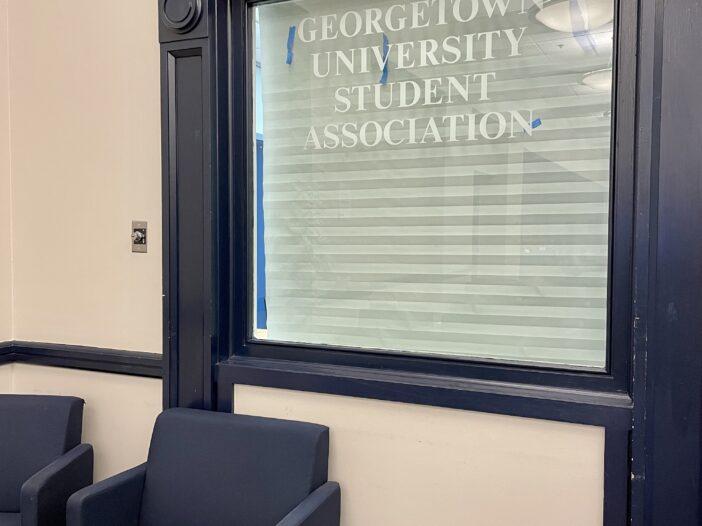The Georgetown University Student Association (GUSA) Senate unanimously passed a resolution to urge the university to support the restoration of the Foundry Branch Trolley Trestle at its Sept. 24 meeting.
The historic Trestle was built in 1896 as part of Washington, D.C.’s extensive trolley car system, but was closed off from public use in 2003 and fell into disrepair. The bridge is now owned by the Washington Metropolitan Area Transit Authority, which has threatened to demolish the bridge in recent years.
Georgetown students have begun collaborating this year with local community advocates in efforts to preserve and restore the trestle. The campaign, called Save the Trestle, aims to push the District Department of Transportation (DDOT) to purchase the trestle and restore it to a pedestrian bridge for historical preservation and accessibility purposes.
The resolution asks the university to change their position from “no comment” to being in support of the campaign, cooperate with DDOT and other affiliated organizations on the restoration and delegate a point of contact between the school, students and the affiliated organizations.
Georgetown’s Advisory Neighborhood Commissioner and founder of Save the Trestle, Joe Massaua (SFS ’25) said that the university has not provided them with a direct person of contact to communicate or discuss their plans with, which has further complicated their efforts.
“One of the key points in the resolution was to have the university establish a point of contact for the trestle. That’s one thing that they had not been doing,” Massaua told The Hoya. “We as a team had been passed around to different officials, depending on what aspects of the trestle movement we were discussing.”
“I think that the point of contact from the university is crucial to ensuring we have productive dialogue,” Massaua added.
The resolution was put forth by GUSA Senator Saatvik Sunkavalli (SFS ’25) and cosponsored by Senator Rob Arzano (CAS ’25) after he motioned to break protocol to introduce legislation. The motion passed 10 to 7, and the resolution was introduced and passed without opposition.

Sunkavalli said that the legislation aims to make the commute from Foxhall to Georgetown’s main campus more accessible. The trestle goes between the McDonough Bus Turnaround and Glover Archbold Park to the Foxhall and Palisades neighborhoods.
“The goal is to make it available for pedestrians to walk across because right now, the way to get from Foxhall to Georgetown is through a very narrow sidewalk down Canal Road. It’s pretty inaccessible,” Sunkavalli said at the meeting.
“It’s very long and very annoying, and there are 270 graduate students that live in Foxhall and a couple of faculty members, and it would just make it a lot easier for people to get from the other side,” Sunkavalli added.
Senator Mason Leath (CAS ’24) spoke in favor of the resolution. Leath said that he lived in the Foxhall neighborhood two summers ago and was frustrated with the difficulty of walking to the main campus.
“It was always so annoying having to walk the trails back behind the school behind the observatory,” said Leath. “And I was always really scared that I was going to get bitten by a bug and get Lyme disease. So I’m very much in favor of this,” he quipped.
No senator spoke in opposition, a contrast to the resolution to endorse ending legacy admissions that GUSA passed earlier this month.
According to Massaua, the next month will be crucial for the trestle initiative, as Oct. 1 marks the beginning of fiscal year 2024 for the D.C. Council, which means the trestle project will gain $250,000 in funding for research into preserving the trestle after Mayor Muriel Bowser (D) approved the council’s proposed budget.
Massaua said he looks forward to the updates and progress to be made on the project in collaboration with GUSA.
“I think it gives us a level of institutional backing from the GUSA Senate as a legislative body, and it supports us when we go and talk to administration officials,” Massaua said.





















Edd Barrows • Oct 10, 2023 at 6:33 am
In the 1970s, I walked on the trestle to enjoy seeing Birds and other wildlife in treetops — a wonderful thing in our Anthropocene biodiversity crisis. Dr. James Tate, Jr., former Director of the Cornell University Laboratory of Ornithology, observed Birds in Glover Archbold Park and adjacent Whitehaven Park from about 1987–2007. He recorded 79 bird species and saw 30 of the species nesting in the Parks. The other 49 species were passing through the Parks during migration and other times. It would be super to have a sky walk again, especially with safety features. The famous animal behaviorist and Bird enthusiast John Alcock once joined me for a walk on the trestle. This is Washington, D.C.’s last standing historical trolly trestle. Edd Barrows, GU Professor of Biology Emeritus.
Barrows, E. M. 2023. The Washington, D.C., Area Ecosystem. Xylocopa Press, Bethesda, MD. Kindle e-book. About 470 pp. and 95 photographs. (has a chapter on Glover Archbold Park)
Lazo, Luz. 2018. D.C.’s last trolley trestle is in ‘imminent risk of collapse’. Washington Post 15 February. Online (February 15, 2022)
[I added Inglima’s Hoya article to my 2024 book draft.]
Chris Thompson C'75 • Oct 3, 2023 at 11:52 am
In my GTown undergraduate days (1971-75), many of us routinely used the trestle to get to and from Foxhall/MacArthur because a lot of Hoyas lived up there (and, I see, still do). It was cross-tie walking at height, but we still did it rather than going down to Canal Road with its tiny sidewalk and zooming traffic whizzing by your elbow. Today, it makes a lot of sense to renovate and reuse that trestle, both for ease of access, Canal Road pedestrian safety, and to reopen the Glover-Archbold Nature Trail’s access to its Canal Road terminus. Seems like a no-brainer.